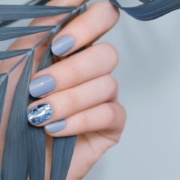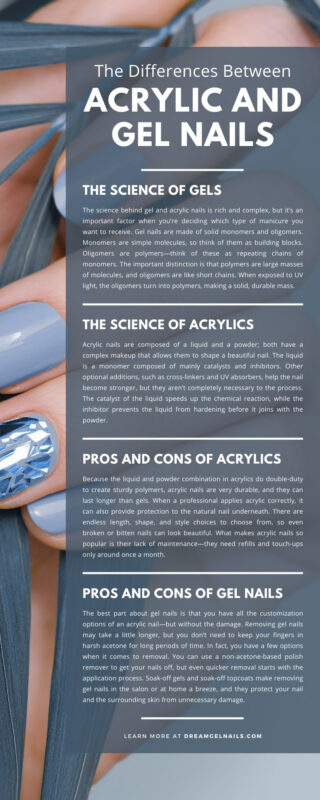The Differences Between Acrylic and Gel Nails
When you’re deciding on what type of manicure you want to receive, knowing your options and the differences between them is essential. Gel and acrylic have long since been fighting for the top spot as the best type of manicure. The truth is that both gel and acrylic manicures are great options. However, the differences between acrylic and gel nails vary widely, and which one you should choose depends on your individual needs.
The Science of Gels
The science behind gel and acrylic nails is rich and complex, but it’s an important factor when you’re deciding which type of manicure you want to receive. Gel nails are made of solid monomers and oligomers. Monomers are simple molecules, so think of them as building blocks. Oligomers are polymers—think of these as repeating chains of monomers. The important distinction is that polymers are large masses of molecules, and oligomers are like short chains. When exposed to UV light, the oligomers turn into polymers, making a solid, durable mass.
That might seem overly complex, but in short, this chemical reaction is intended to make the strongest molecule possible to give you a sturdy nail. Energy-curable resins and photoinitiators are the chemicals that help this strengthening process along. Gel polish also contains a stabilizing chemical and an inhibiting chemical—the former to prevent discoloration, and the latter to prevent the monomers from prematurely polymerizing, or hardening.
The Science of Acrylics
Acrylic nails are composed of a liquid and a powder; both have a complex makeup that allows them to shape a beautiful nail. The liquid is a monomer composed of mainly catalysts and inhibitors. Other optional additions, such as cross-linkers and UV absorbers, help the nail become stronger, but they aren’t completely necessary to the process. The catalyst of the liquid speeds up the chemical reaction, while the inhibitor prevents the liquid from hardening before it joins with the powder.
The powder is a polymer containing an initiator. Remember, polymers are long chains of monomers, and initiators are molecules that absorb energy and speed up chemical reactions. Sometimes, the powder will contain colorants or titanium dioxide, both of which are intended to change the color of the powder to make the resulting nail look brighter, pinker, or whiter.
When combined in the proper ratio, the liquid and powder will form an acrylic bead. The polymers in the powder and the monomers in the liquid cause the monomers to polymerize, turning those building blocks into durable chains, which is how you get that sturdy 3D nail shape.
The Application Processes
The science and the application processes of gel and acrylic are similar, but they have a few key differences. When applying a gel nail, your nail artist will use a sculpting gel, a brush, nail forms, a colored lacquer, and a base coat and topcoat. First, your nail artist will apply the nail form, which acts as a base and a measuring guide to shape the nail; then, they’ll apply the base coat. Afterward, your nail artist will start to build the nail with the building gel. Next, they’ll apply the chosen color and the topcoat. It’s important to note that between each layer and product, your nails will have to harden under a UV lamp for two to five minutes.
The process of applying acrylic looks almost identical. However, this process requires the liquid and the powder to form the nail and create a sturdy set of polymers. In addition, acrylics don’t need a UV light to harden; they do so naturally on their own as they dry and the inhibitor wears off.
Pros and Cons of Acrylics
Because the liquid and powder combination in acrylics do double-duty to create sturdy polymers, acrylic nails are very durable, and they can last longer than gels. When a professional applies acrylic correctly, it can also provide protection to the natural nail underneath. There are endless length, shape, and style choices to choose from, so even broken or bitten nails can look beautiful. What makes acrylic nails so popular is their lack of maintenance—they need refills and touch-ups only around once a month.
However, acrylic nails can still be very damaging to the natural nail. If the acrylic isn’t applied properly, dirt and bacteria can get trapped between the acrylic and the natural nail, which can lead to infection and cause your real nail to become pus filled and painful—and in worst-case scenarios, the natural nail can fall off. In addition, if you catch an acrylic nail on an object, the item can pull at the nail, causing a lot of pain.
The main con of acrylic is the damage it causes when the nail artist takes it off. It’s a harsh process that involves soaking the nails in acetone for a long time. This just isn’t a viable option for people who are prone to dry or sensitive skin. The removal process can leave even normal skin raw and dry, and it can also result in cracks or fissures in the natural nails, making new, healthy nail growth more difficult.
Pros and Cons of Gel Nails
The best part about gel nails is that you have all the customization options of an acrylic nail—but without the damage. Removing gel nails may take a little longer, but you don’t need to keep your fingers in harsh acetone for long periods of time. In fact, you have a few options when it comes to removal. You can use a non-acetone-based polish remover to get your nails off, but even quicker removal starts with the application process. Soak-off gels and soak-off topcoats make removing gel nails in the salon or at home a breeze, and they protect your nail and the surrounding skin from unnecessary damage.
Gel is a fantastic option for people who want to protect their natural nails or who have sensitive skin, but it has two downsides. The first is that gel nails require more expensive products and training, so a gel manicure is on the pricier side. In addition, gel manicures need more maintenance, and they only last about two weeks.
Which One You Should Choose
Ultimately, there are a few factors to pay attention to when you’re deciding which manicure to pick. If you’re looking for a dramatic nail style that’s quick and affordable, then acrylic nails are for you. They’re strong, long lasting, and accessible to most people. However, if you have sensitive skin or value the health of your natural nail, then gel nails will benefit your more.
At the end of the day, it’s all about what’s best for you. So if you’re having trouble deciding, you may want to give both a try and determine which type of manicure makes you the most comfortable.
The differences between gel and acrylic nails may not seem significant to some people, but the details greatly affect the resulting product. If you’re looking for a gentle, natural gel manicure, Dream Gel and Dream Gel products will soften the cuticles, prevent cuticle overgrowth, and help you rebuild damaged nail beds so that you can have a healthy foundation for your next manicure.




